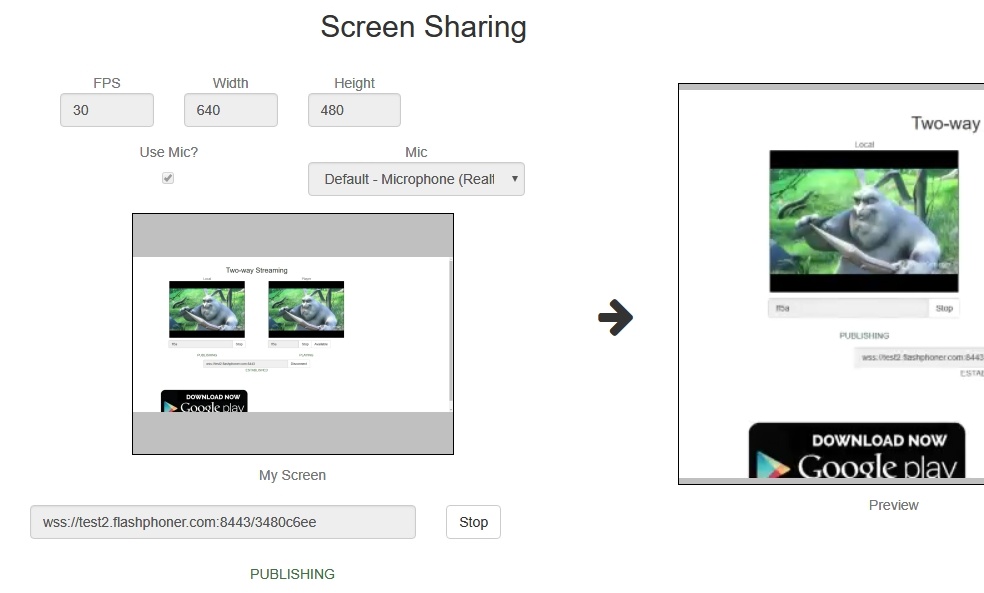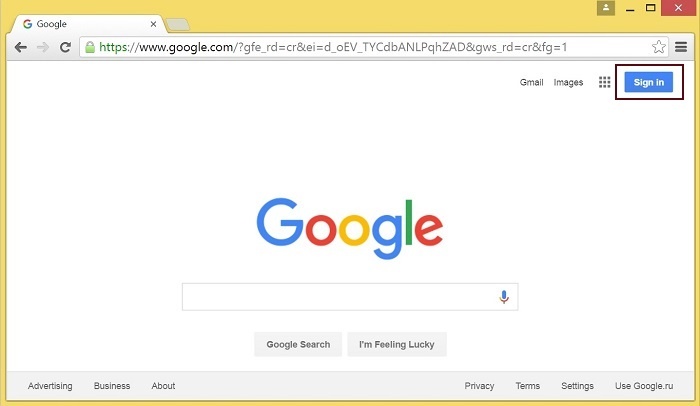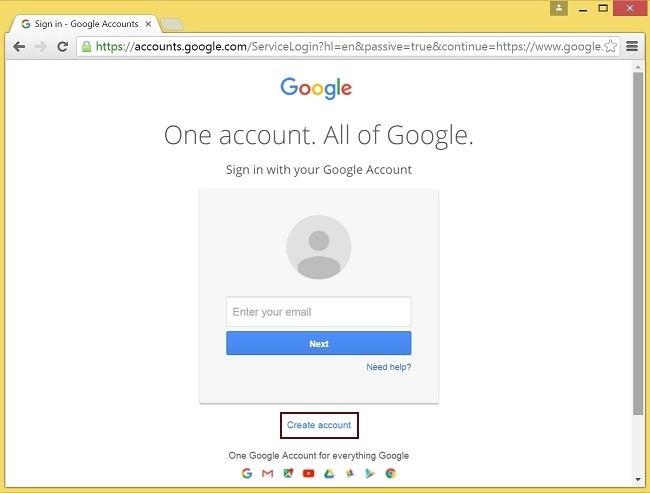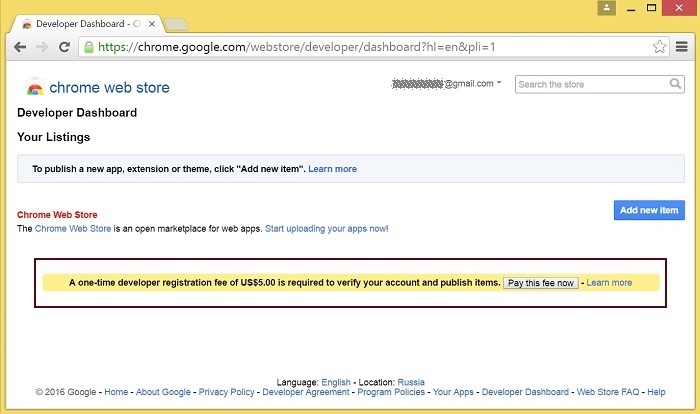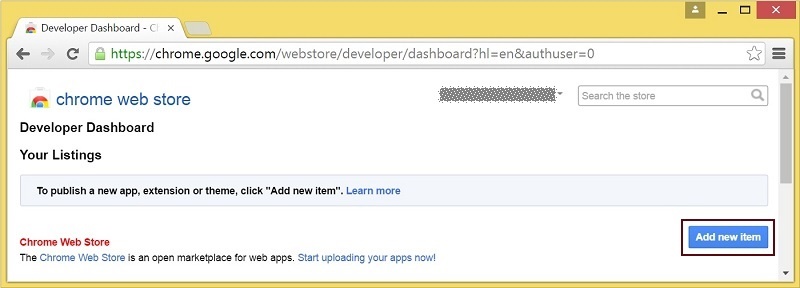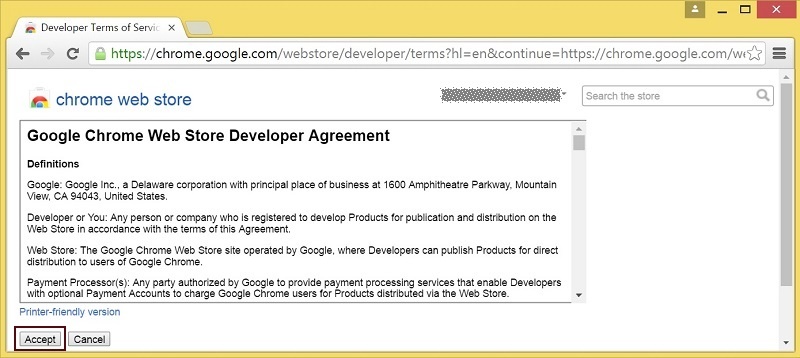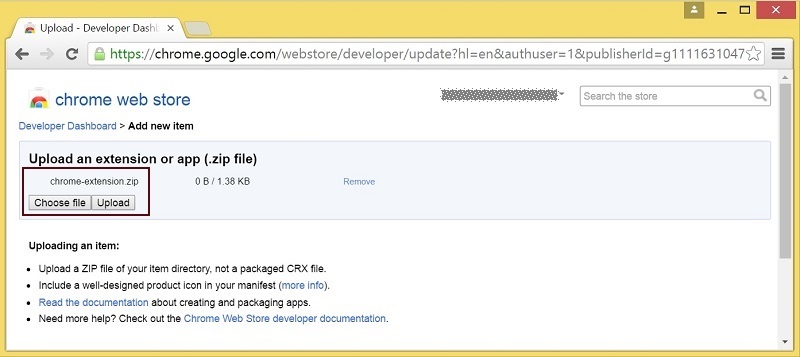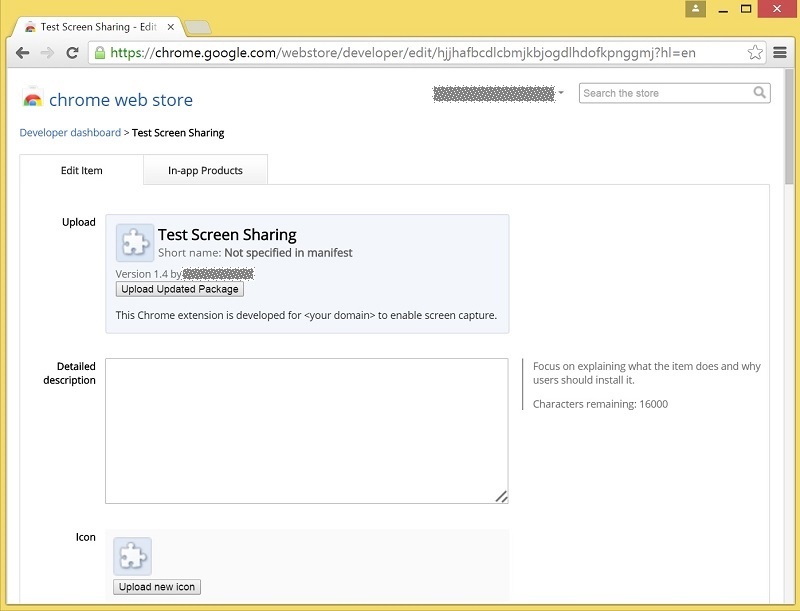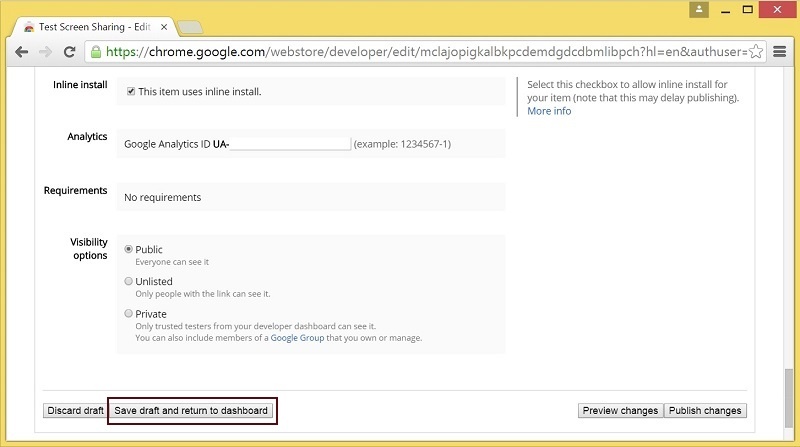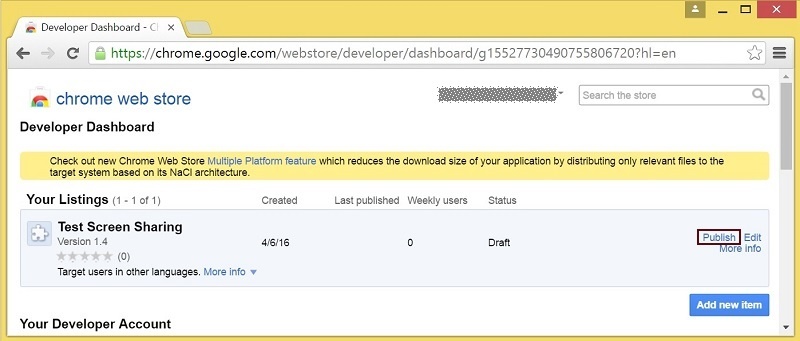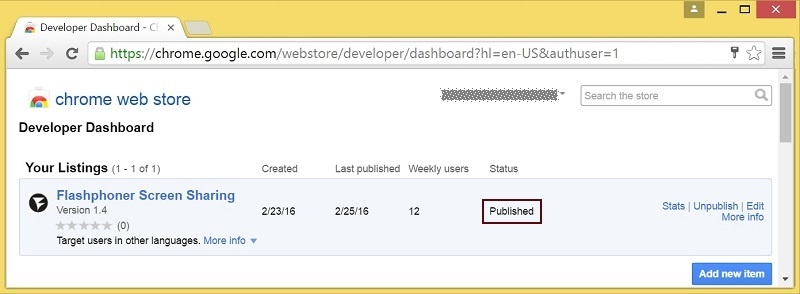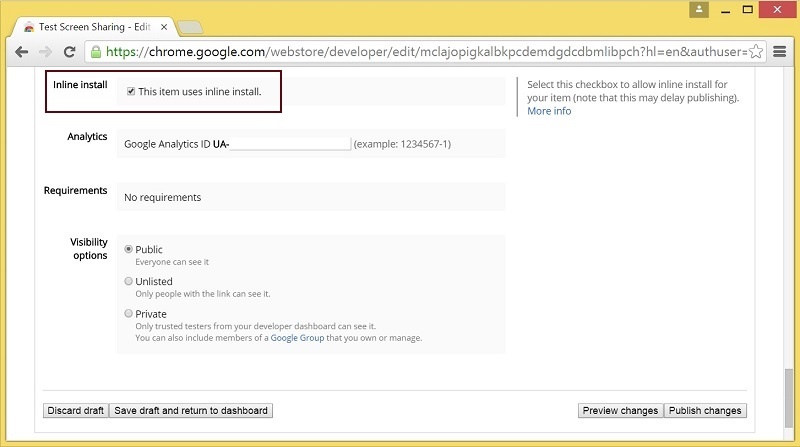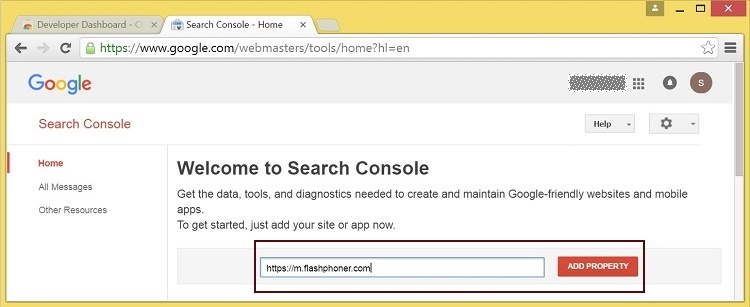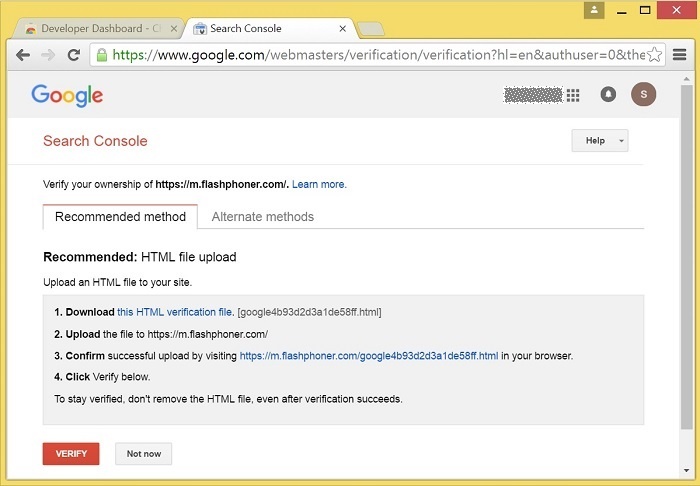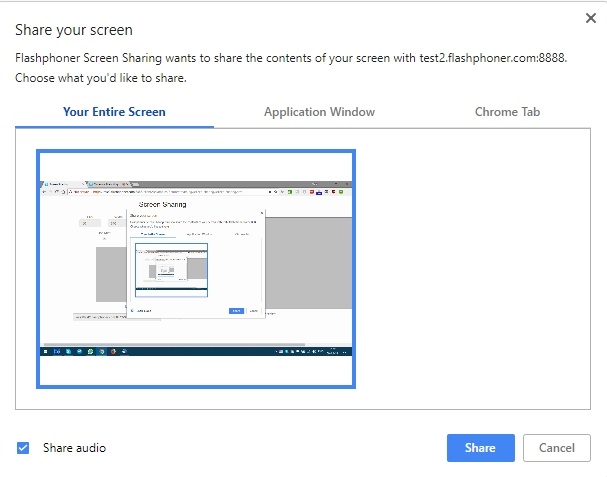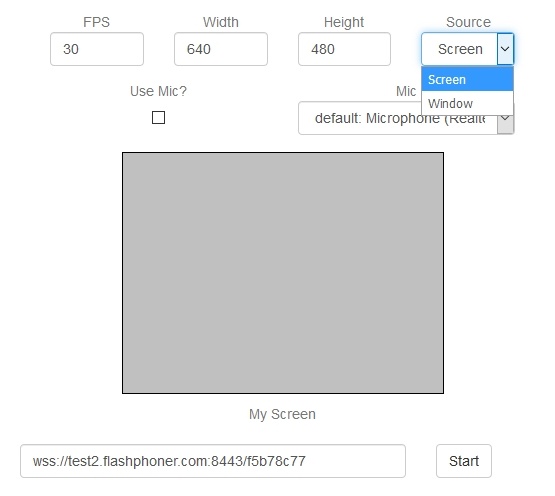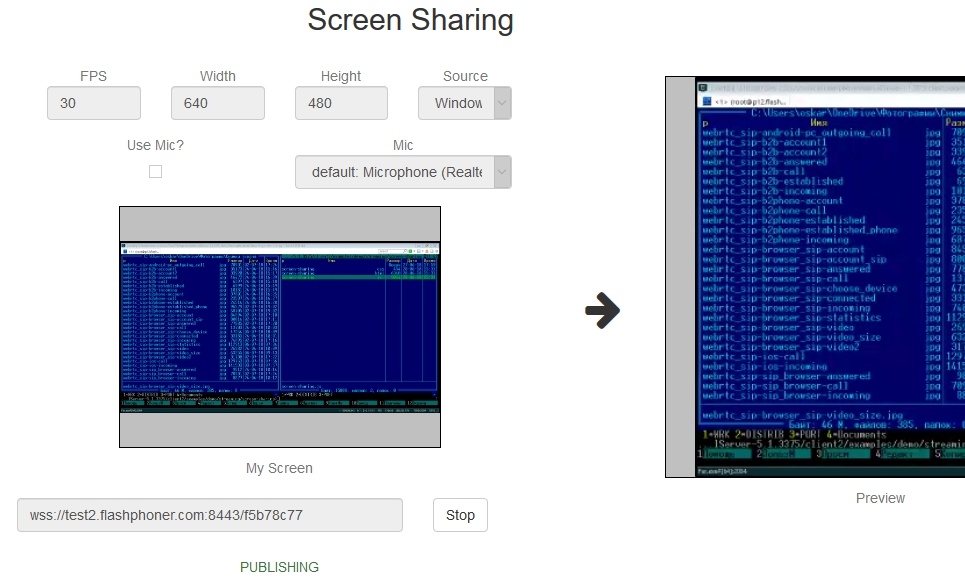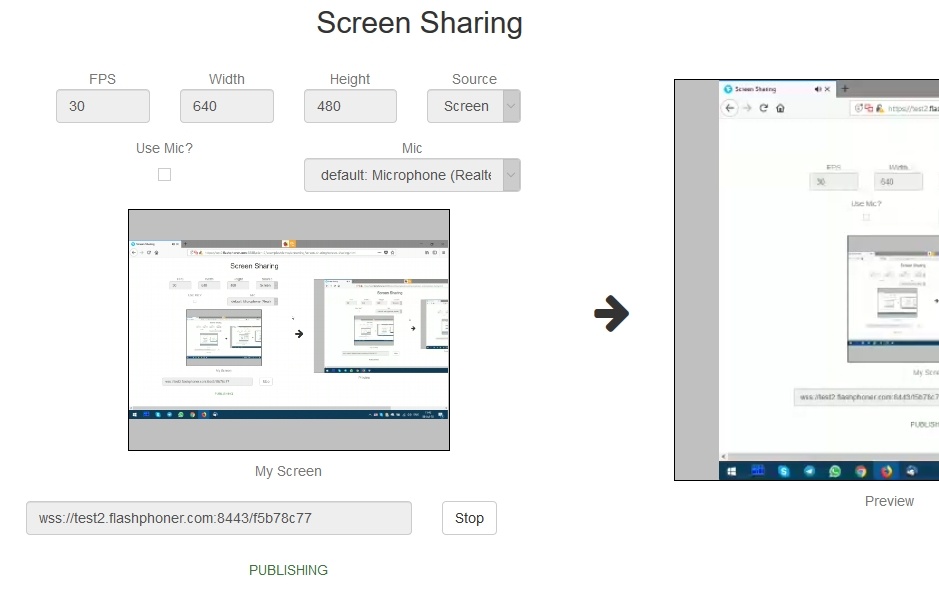Screen sharing example
Screen sharing is available for Chrome and Firefox. To share screen in Chrome before 73 the extension need to build and install, in the latest Chrome versions (73 and newer), Firefox and Safari screen can be shared without extension. Today, it is not recommended to use extension.
Source code for the extension is available by the following link: Chrome Screen Sharing Extension 1. Go to google.com and click ‘Sign in’ button 2. On the ‘Sign in’ page, click ‘Create account’ link 3. ‘Create your Google Account’ page will be opened 1. Sign in to Chrome Developer Dashboard with the created Google account Follow the procedures described below to use the extensions with your domain. Change: Save your icons for the extension to chrome-extension directory and edit the file names in "icons" and "web_accessible_resources". (For more information, see Manifest - Icons and Supplying Images.) Package files from chrome-extension folder into ZIP archive. 1. Sign in to Chrome Developer Dashboard 3. Accept the developer agreement 4. On the ‘Upload’ page, choose the chrome-extension.zip file and click ‘Upload’ button 5. When the extension is uploaded, the page for editing the extension draft will be opened 6. The extension will appear in the developer dashboard A published extension will have status ‘Published’ as on the image below. For more information, see Chrome Web Store Publishing Tutorial. Extension installation can be initiated by clicking a link on the Screen Sharing client page. Follow the procedures described below to use the client with your extensions. 1. When publishing, select ‘Inline Install’ option 2. Verify and add website with your domain to the extension - Google Search Console page will open in a new tab - A page with the instruction for the site verification will open - If the verification is passed, a page confirming successful verification will be opened - The website will appear in the list in the extension options and the extension can be associated with the site Edit Screen-sharing.html and Screen-sharing.js To get the ID of the extension, click ‘More info’ of this extension in Chrome Developer Dashboard. To configure screen media source parameters, use parameters of the Configuration object passed to the init() method upon initializing of the Flashphoner API instance. Parameter Description screenSharingVideoWidth Screen media source width screenSharingVideoHeight Screen media source height screenSharingVideoFps Screen media source framerate These parameters set marginal values of resolution and framerate (FPS). For instance, screenSharingVideoWidth = 1080 means the width of the source video cannot be more than 1080 pixels, but can be less. (i.e. when sending a stream of an app window that has the width of 720 pixels). In Chrome browser, there is ability to translate audio stream from system sound source while capturing a screen. The feature is useful in screencasting, for example. To capture system sound, set "Share audio" option in Chrome extension dialog window while choosing streaming source window or browser tab: Chrome extension code: In Firefox browser, all the screen or some program window can be chosen as video stream source with constraints.video.mediaSource parameter code: Source selection interface example: Program window capture Screen capture Firefox browser does not use extension to share screen Since Chrome 73 and Flashphoner WebSDK 0.5.28.2753.86 screen sharing is possible without extension. To do this Since Safari 13 and Flashphoner WebSDK 0.5.28.2753.152 screen sharing is possible without extension. To do this 1. In Chrome browser, picture resolution and FPS are set by source dimensions (screen, windows or browser tab) and by real picture updating speed, not by constraints/ This issue is fixed since Flashphoner WebSDK build 0.5.28.2753.152 2. System sound capture only works starting from Crome 74Extension for Google Chrome with publication in Chrome Store
Create a Google account
Fill the required fields and click ‘Next step’ button to create the account.Register as Chrome Web Store Developer
2. Pay a one-time $5 developer signup feeCustomization for your domain
Edit manifest file manifest.json of the Chrome extension.Package the extension
Publish the extension
2. In the dashboard, click ‘Add new item’ button
Edit the extension as required and click ‘Save draft and return to dashboard’ button at the bottom of the page.
Click ‘Publish’ link to publish the extension.Extension Inline Installation
Note that the extension to be installed should be customized, published and approved before inline installation can be used.
- Click ‘Add a New Site’
Enter URL with your domain.
Follow the procedure steps and click ‘Verify’ button.Configuring the client
Media source parameters
var f = Flashphoner.getInstance();
var configuration = new Configuration();
....
configuration.screenSharingVideoWidth = 1920;
configuration.screenSharingVideoHeight = 1080;
configuration.screenSharingVideoFps = 10;
f.init(configuration);
Parameter list
System sound capture in Chrome browser
callback({sourceId: sourceId, systemSoundAccess: opts.canRequestAudioTrack});
Capture source (screen or window) management in Firefox browser
constraints.video.type = "screen";
if (Browser.isFirefox()){
constraints.video.mediaSource = $('#mediaSource').val();
}
session.createStream({
name: streamName,
display: localVideo,
constraints: constraints
})
Screen sharing without extension
Firefox browser
Chromium based browsers
constraints.video.withoutExtension parameter should be passed when stream is created if ($("#woChromeExtension").prop('checked')) {
constraints.video.withoutExtension = true;
}
Safari browser in MacOS
constraints.video.withoutExtension parameter should be passed when stream is created if ($("#woChromeExtension").prop('checked') || Browser.isSafari()) {
constraints.video.withoutExtension = true;
}
Known limits
Code of the example
This example uses Flashphoner extensions for work with domain *.flashphoner.com. For work with your domain, build up and publish your extensions as described above.
As temporary solution, IP address of your WCS server can be added to file C:\Windows\System32\drivers\etc\hosts (on Windows OS) as test.flashphoner.com. That way, you will be able to test your WCS server with domain test.flashphoner.com till the extensions for your domain are built up.
With Chrome, the example works only by https://.
The path to the source code of the example on WCS server is:
/usr/local/FlashphonerWebCallServer/client/examples/demo/streaming/screen-sharing
screen-sharing.css - file with styles
screen-sharing.html - page of the screen sharing streamer
screen-sharing.js - script providing functionality for the streamer
This example can be tested using the following address:
https://host:8888/client/examples/demo/streaming/screen-sharing/screen-sharing.html
Here host is the address of the WCS server.
For Chrome, link to the extension is specified directly in file screen-sharing.html line 17
<link rel="chrome-webstore-item" href="https://chrome.google.com/webstore/detail/nlbaajplpmleofphigmgaifhoikjmbkg">
Analyzing the code
1. Initialization of the API.
Flashphoner.init() code
Chrome extension ID is passed to the init() method.
Flashphoner.init({screenSharingExtensionId: extensionId});
2. Connection to WCS server.
Flashphoner.createSession() code
Flashphoner.createSession({urlServer: url}).on(SESSION_STATUS.ESTABLISHED, function(session){
//session connected, start streaming
startStreaming(session);
}).on(SESSION_STATUS.DISCONNECTED, function(){
setStatus(SESSION_STATUS.DISCONNECTED);
onStopped();
}).on(SESSION_STATUS.FAILED, function(){
setStatus(SESSION_STATUS.FAILED);
onStopped();
});
3. Receiving the event confirming successful connection
ConnectionStatusEvent ESTABLISHED code
Flashphoner.createSession({urlServer: url}).on(SESSION_STATUS.ESTABLISHED, function(session){
//session connected, start streaming
startStreaming(session);
}).on(SESSION_STATUS.DISCONNECTED, function(){
...
}).on(SESSION_STATUS.FAILED, function(){
...
});
4. Stream constraints setting
resolution and fps code
var constraints = {
video: {
width: parseInt($('#width').val()),
height: parseInt($('#height').val()),
//WCS-2014. fixed window/tab sharing
frameRate: parseInt($('#fps').val())
}
};
michrophone usage code
if ($("#useMic").prop('checked')) {
constraints.audio = {
deviceId: $('#audioInput').val()
};
}
video source type and Chrome screen sharing without extension code
constraints.video.type = "screen";
if ($("#woChromeExtension").prop('checked')) {
constraints.video.withoutExtension = true;
}
Firefox media source code
if (Browser.isFirefox()){
constraints.video.mediaSource = $('#mediaSource').val();
}
5. Video streaming
session.createStream(), publish() code
session.createStream({
name: streamName,
display: localVideo,
constraints: constraints
...
}).publish();
6. Receiving the event confirming successful streaming
StreamStatusEvent PUBLISHING code
When the screen sharing stream is published, preview video stream is created with method session.createStream(), and function play() is called to start playback of the stream in <div> element 'remoteVideo'.
session.createStream({
name: streamName,
display: localVideo,
constraints: constraints
}).on(STREAM_STATUS.PUBLISHING, function(publishStream){
/*
* User can stop sharing screen capture using Chrome "stop" button.
* Catch onended video track event and stop publishing.
*/
document.getElementById(publishStream.id()).srcObject.getVideoTracks()[0].onended = function (e) {
publishStream.stop();
};
document.getElementById(publishStream.id()).addEventListener('resize', function(event){
resizeVideo(event.target);
});
setStatus(STREAM_STATUS.PUBLISHING);
//play preview
session.createStream({
name: streamName,
display: remoteVideo
...
}).play();
}).on(STREAM_STATUS.UNPUBLISHED, function(){
...
}).on(STREAM_STATUS.FAILED, function(){
...
}).publish();
7. Receiving the event confirming successful preview stream playback
StreamStatusEvent PLAYING code
session.createStream({
name: streamName,
display: remoteVideo
}).on(STREAM_STATUS.PLAYING, function(previewStream){
document.getElementById(previewStream.id()).addEventListener('resize', function(event){
resizeVideo(event.target);
});
//enable stop button
onStarted(publishStream, previewStream);
}).on(STREAM_STATUS.STOPPED, function(){
...
}).on(STREAM_STATUS.FAILED, function(){
...
}).play();
8. Preview stream playback stop
stream.stop() code
function onStarted(publishStream, previewStream) {
$("#publishBtn").text("Stop").off('click').click(function(){
$(this).prop('disabled', true);
previewStream.stop();
}).prop('disabled', false);
}
9. Receiving the event confirming successful playback stop
StreamStatusEvent STOPPED code
On receiving the event, publishStream.stop() is called to stop screen sharing streaming
session.createStream({
name: streamName,
display: remoteVideo
}).on(STREAM_STATUS.PLAYING, function(previewStream){
...
}).on(STREAM_STATUS.STOPPED, function(){
publishStream.stop();
}).on(STREAM_STATUS.FAILED, function(){
...
}).play();
10. Screen sharing streaming stop by click on Chrome extension button
publishStream.stop(). code
document.getElementById(publishStream.id()).srcObject.getVideoTracks()[0].onended = function (e) {
publishStream.stop();
};
11. Receiving the event confirming successful streaming stop
StreamStatusEvent UNPUBLISHED code
session.createStream({
name: streamName,
display: localVideo,
constraints: constraints
}).on(STREAM_STATUS.PUBLISHING, function(publishStream){
...
}).on(STREAM_STATUS.UNPUBLISHED, function(){
setStatus(STREAM_STATUS.UNPUBLISHED);
//enable start button
onStopped();
}).on(STREAM_STATUS.FAILED, function(){
...
}).publish();
